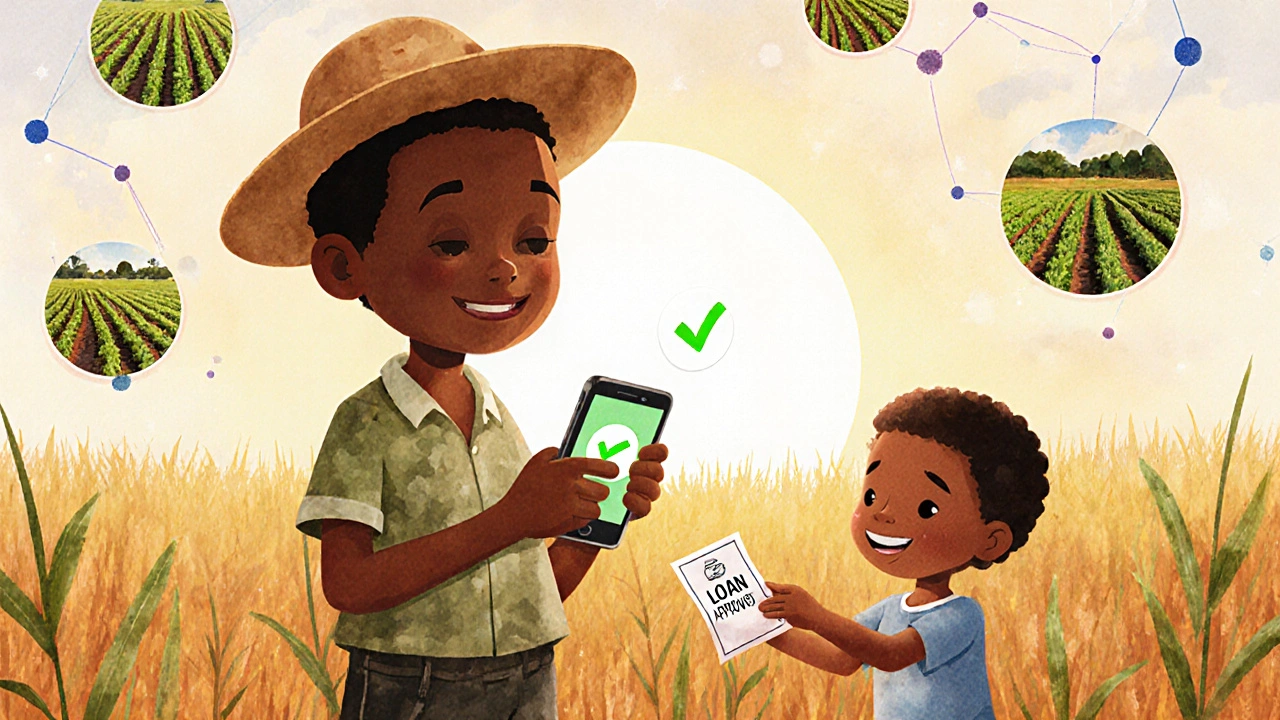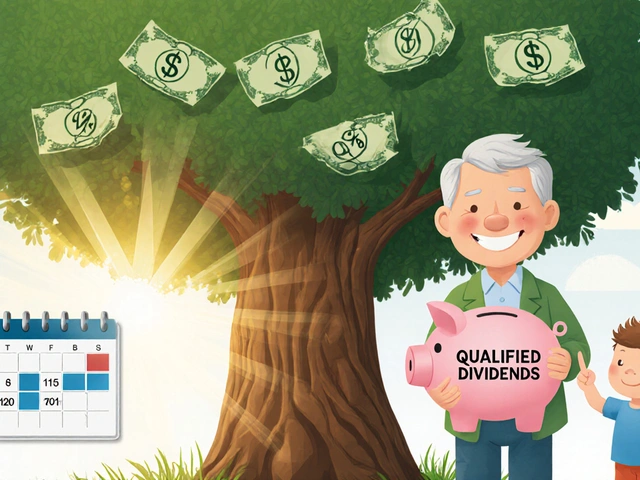Crop Insurance Payout Calculator
See if you qualify for instant parametric insurance payouts based on rainfall data. This tool uses real-world thresholds from agri-fintech platforms.
Smallholder farmers feed the world. But most can’t get a loan or insurance.
Imagine planting your entire year’s crop with no safety net. No bank will lend you $500 because you don’t have a credit score. When the rains fail, you lose everything - and there’s no payout, no help, no backup plan. This isn’t a scene from a movie. It’s the daily reality for over 500 million smallholder farmers around the world. They grow 80% of the food in developing countries, yet they’re locked out of the financial system. That’s where agri-fintech comes in.
Agri-fintech isn’t just another buzzword. It’s the real-world fusion of mobile tech, satellite data, and financial tools built specifically for farmers who’ve been ignored by traditional banks. Instead of requiring paperwork, collateral, or years of credit history, these platforms use something farmers already have: their phone, their land, and their harvest patterns.
How agri-fintech loans work - no collateral needed
Traditional banks won’t lend to small farmers because they don’t have titles to land, pay stubs, or bank statements. Agri-fintech companies solve this by looking at data no bank ever considered. They track mobile money transactions. They analyze satellite images of crop health. They check when and how often a farmer sells produce at local markets.
In India, platforms like Aggois approve loans of as little as ₹2,000 (about $24) in under 48 hours. In Kenya, farmers get $500 advances for seeds and fertilizer through apps like M-KOPA Agri. In the U.S., Steward offers loans starting at $500 with repayment tied to harvest season - not monthly bills. That’s a game-changer. Traditional agricultural loans take weeks to process. Agri-fintech loans? Done in 1 to 3 days.
These loans aren’t just faster. They’re smarter. If a farmer usually sells maize every October, the system knows to let them repay in November or December - after the crop is sold. Most traditional lenders demand payments every month, rain or shine. That’s why 87% of agri-fintech loan products sync repayment with harvest cycles. Only 12% of bank loans do.
Parametric insurance: Pay out before you even file a claim
Traditional crop insurance is broken. Farmers wait 3 to 6 months just to get an adjuster out to their field. By then, it’s too late. Agri-fintech insurance fixes this with something called parametric insurance.
Here’s how it works: If rainfall in your region drops below 150mm during the growing season - a number set by scientists and agreed upon by your insurer - your payout triggers automatically. No surveyors. No paperwork. No delays. Satellite data and weather stations monitor the rain. If the trigger is hit, cash lands in your phone within 24 to 72 hours.
This isn’t science fiction. In Ethiopia, farmers using digital insurance saw payouts in 14 days after drought. Traditional insurance? 120+ days. In Kenya, ACRE Africa’s parametric policy paid out to 12,000 maize farmers after a single dry spell - all without stepping foot on a single farm.
There are downsides. Sometimes the rain falls just outside your field, but not enough to trigger the payout. That’s called basis risk - and it affects 18% to 22% of policies. But even with that flaw, farmers say it’s better than nothing. In one field study, 63% of farmers in Kilifi County said they’d use it again because the speed saved their next planting season.

Why mobile phones are the new bank branch
You don’t need a fancy smartphone. Most agri-fintech apps work on Android 8.0 or older - phones you can buy for under $50. In rural Africa and India, 92% of platforms offer USSD codes: type *123# and follow the menu to check your loan balance, apply for insurance, or get weather alerts. No internet needed.
Platforms like One Acre Fund and M-KOPA don’t just sell loans. They bundle them with training, seeds, and fertilizer. Farmers get a text message: “Your urea fertilizer is ready at the depot. Use your loan to pick it up.” Then, weeks later: “Your crop looks healthy. Your insurance is active.”
This integration is the secret sauce. Farmers don’t have to learn 5 different apps. They don’t have to remember 10 different deadlines. Everything is tied together. That’s why integrated models - credit + insurance + inputs + advice - are 55% more effective than standalone products, according to UNDP’s 2023 study.
Who’s winning - and who’s falling behind
India leads the world with over 50 agri-fintech platforms serving 25 million farmers. The government’s PMFBY scheme now covers 28.6 million farmers - up from 5.7 million in 2016. The U.S. has 15+ platforms, mostly focused on specialty crops like almonds and avocados, with $1.2 billion in outstanding loans as of 2023.
Africa is growing fast. Thirty platforms now serve 12 million farmers. But the biggest barrier isn’t tech - it’s trust. In East Africa, 67% of farmers worry about how their data is used. Will a company sell their harvest history to a buyer? Will their phone number be shared with lenders who charge extra fees? These aren’t paranoid fears. In India, 58% of farmers said they didn’t know who owned their data.
That’s why platforms that offer clear privacy policies and local-language support are winning. Ninety-two percent of successful African platforms use field agents - real people who walk into villages with tablets, help farmers sign up, and explain insurance in Swahili or Hausa. One farmer in Nigeria told a researcher: “I didn’t understand the app. But when Amina came to my compound and showed me the rain graph on her phone, I knew I was protected.”
The hidden costs - and who pays them
Agri-fintech isn’t charity. It’s business. And that means interest rates. In the U.S., Steward charges 15% to 18% APR. Some farmers call it “loan shark territory.” But compare that to a local moneylender charging 40% to 100% - suddenly, it looks better.
Insurance premiums are also higher than traditional policies. A parametric policy might cost 8% of the crop value. A bank-backed policy? 3%. But here’s the catch: the bank policy rarely pays out. The parametric one does - fast.
And then there’s the learning curve. In the U.S., farmers need 2 to 3 hours of training. In India, it’s 8 to 12 hours. In parts of rural Mali or Bangladesh? Up to 20 hours. That’s why platforms that pair tech with human support see 40% higher adoption rates.
Only 28% of agri-fintech companies are profitable. Many rely on donor funding or government subsidies. But that’s changing. Platforms that bundle services - like One Acre Fund - are surviving because they make money on inputs and market access, not just loans.
What’s next? AI, carbon credits, and land titles
The next wave is even smarter. In Kenya, Global Parametrics is using AI to predict crop failure down to the individual farm - not just the region. Accuracy improved by 27% in pilot tests. In Rwanda, blockchain is being used to record land ownership. Before, farmers couldn’t use land as collateral because titles were handwritten and disputed. Now, digital titles have increased credit access by 34%.
And then there’s carbon. One Acre Fund’s 2023 pilot let farmers earn $12.50 per acre by planting trees and using low-till methods. That money went straight into their digital wallet. Now, farmers aren’t just protecting their crops - they’re getting paid to heal the soil.
But here’s the big question: Can this scale? Climate change is making droughts and floods more frequent. The IPCC says agricultural risk has jumped 35% since 2000. That means more farmers will need help. And if agri-fintech can’t keep up - or if it locks farmers into debt - the damage could be worse than before.
What farmers really need
Agri-fintech isn’t the magic fix. But it’s the first real step toward financial dignity for smallholder farmers. It’s not about fancy apps or AI. It’s about trust. About timely cash. About knowing that when the storm hits, you won’t lose everything.
What works? Integrated services. Local language. Human support. Transparency. Fair rates. And payouts that come before you’re already in crisis.
The goal isn’t to replace banks. It’s to give farmers a chance - not a loan, not an insurance policy - but a chance to plan, grow, and survive. And that’s something no algorithm can take away.




It’s fascinating how technology, when rooted in empathy rather than profit, can restore dignity to people who’ve been treated as statistical noise for centuries. I’ve seen farmers in Bihar who didn’t know what a credit score was - but they knew the rhythm of the monsoon, the texture of their soil, the way their children’s laughter changed when the harvest failed. Agri-fintech doesn’t just give them loans; it gives them back the ability to dream in more than survival mode. The fact that repayment syncs with harvest cycles? That’s not innovation - that’s common sense. Why would anyone demand payments in January when the field is bare? It’s like asking a baker to pay rent before the bread is baked. And yet, banks have done this for decades. The real breakthrough isn’t the satellite data or the USSD codes - it’s the quiet, stubborn refusal to treat human beings like risk profiles. If we can scale this with integrity, we might just rewrite the rules of finance itself - not for shareholders, but for soil, sweat, and survival.
Look, the agri-fintech space is basically DeFi with dirt on its boots. Parametric insurance triggered by satellite data? That’s a black-box algorithm betting on rainfall patterns - and farmers are the collateral. Sure, payouts are faster than traditional insurance, but basis risk is still a fucking landmine. And let’s not romanticize the ‘human touch’ - field agents are just low-wage data collectors for VC-backed startups that’ll pivot to fintech SaaS the second margins dip. The 15% APR? That’s predatory if you’re comparing it to government-subsidized credit. And don’t get me started on carbon credits being bundled in - that’s just greenwashing with a QR code. This isn’t financial inclusion. It’s financialization of subsistence. The real win? The platforms. The farmers? They’re still one drought away from debt slavery, just with a better app interface.
lol.